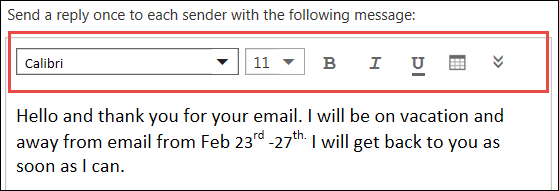Use automatic replies to tell people you won't be responding right away to their email messages. This kind of auto-reply "out of office" message is sent only once to each person who sends email to you while you're away.
Note: If the instructions don't match what you see, you might be using an older version of Outlook on the web. Try the Instructions for classic Outlook on the web.
-
At the top of the page, select Settings > Mail > Automatic replies.
-
Select the Turn on automatic replies toggle.
-
Select the Send replies only during a time period check box, and then enter a start and end time.
If you don't set a time period, your automatic reply remains on until you turn it off by selecting the Automatic replies on toggle.
-
Select the check box for any of the following options that you're interested in:
-
Block my calendar for this period
-
Automatically decline new invitations for events that occur during this period
-
Decline and cancel my meetings during this period
-
-
In the box at the bottom of the window, type a message to send to people during the time you're away.
If you like, you can use the formatting options at the top of the box to change the font and color of the text or customize your message in other ways.
-
If you want senders outside your organization to get automatic replies, select the check box for Send replies outside your organization.
-
When you're done, select Save at the top of the window.
If you didn't set a time period for automatic replies (step 4 earlier), you'll need to turn them off manually. To turn off automatic replies, sign in to Outlook on the web, choose Settings 
Instructions for classic Outlook on the web
-
Sign in to Outlook on the web.
-
On the nav bar, choose Settings > Automatic replies.
-
Choose the Send automatic replies option.
-
Select the Send replies only during this time period check box, and then enter a start and end time to control when automatic replies are sent.
If you don't set a time period, your automatic reply remains on until you turn it off by selecting Don't send automatic replies.
-
Select the check box for any of the following options that you're interested in:
-
Block my calendar for this period
-
Automatically decline new invitations for events that occur during this period
-
Decline and cancel my meetings during this period
If you want senders outside your organization to get automatic replies, select the check box for Send automatic reply messages to senders outside my organization.
-
-
In the box at the bottom of the window, type a message to send to people during the time you're away.
-
If you like, you can highlight your message and use the formatting options at the top of the box to change the font and color of the text, add an emoji, or customize your message in other ways.

-
When you're done, choose OK at the top of the page.
If you didn't set a time period for automatic replies (step 4 earlier), you'll need to turn them off manually. To turn off automatic replies, sign in to Outlook on the web, choose Settings > Automatic replies and then select Don’t send automatic replies.
See Also
Send automatic out of office replies from Outlook for Windows
Send automatic out of office replies from Outlook for Mac
Enable automatic out of the office replies from Outlook for Android or Outlook for iOS










